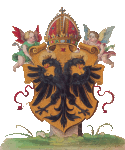

Holy Roman Empire in nummis


Aulic Council (Reichshofrat)
 he Aulic Council (from the Latin aula, court in feudal language, in antiquity a hellenistic type of grand residence, usually private) was originally an executive-judicial council for the Holy Roman Empire.
he Aulic Council (from the Latin aula, court in feudal language, in antiquity a hellenistic type of grand residence, usually private) was originally an executive-judicial council for the Holy Roman Empire.
Known in German as the Reichshofrat(h) (literally meaning Court Council of the Empire) it was one of the two supreme courts of the Empire, the other being the court of the imperial chamber (Reichskammergericht). It had not only concurrent jurisdiction with the latter court, but in many cases exclusive jurisdiction, in all feudal processes, and in criminal affairs, over the immediate feudatories of the Emperor and in affairs which concerned the imperial Government.
Originating during the later Middle Ages as a paid Council of the Emperor, it was organized in its later form by Maximilian I in 1497, as a rival to the Imperial Chamber, which the Diet had forced upon him. It was composed of a president, a vice-president, a vice-chancellor, and 18 councilors, who were all chosen and paid by the Emperor, with the exception of the vice-chancellor, who was appointed by the Elector of Mainz. Of the 18 councilors, six were Protestants, whose votes, when they were unanimous, were an effective veto, so that a religious parity was to some extent preserved.
All matters were decided by the whole Council. In case of split votes, the president could break the tie, or he could choose to refer the matter to the Emperor. In religious matters, an even split automatically referred the matter to the Reichstag
The seat of the Aulic Council was at the Imperial residence, in Vienna. On the death of the Emperor, the Council was dissolved and had to be reconstructed by his successor.
Source: Wikipedia / heraldica.org





